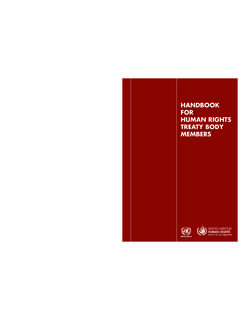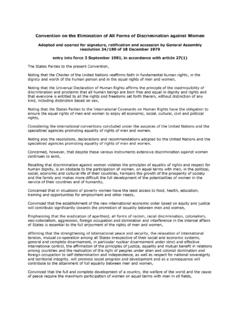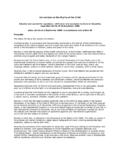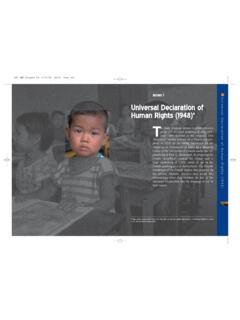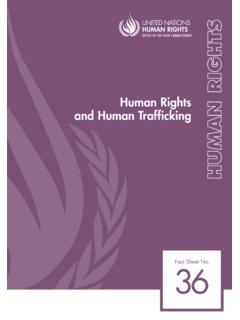Transcription of CLIMATE CHANGE QUESTIONNAIRE
1 1 Inputs for OHCHR's Analytical Study on the Impacts of CLIMATE CHANGE on the Enjoyment of the Right to Health (Human Rights Council Resolution 29/15) Contribution by Saudi Arabia CLIMATE CHANGE QUESTIONNAIRE 2 1- Please describe in your view the relationship between CLIMATE CHANGE and the enjoyment of the right to health and any human right obligations to mitigate and adopt to CLIMATE CHANGE that can be derived there from 2- please share summary of any relevant data on the impact of CLIMATE CHANGE on the enjoyment of human right to health including its underlying determinants(education water and sanitation food housing ) disaggregate to the extent possible Answer Q1 and Q2 : Although global warming may bring some localized benefits, such as fewer winter deaths in temperate climates and increased food production in certain areas, the overall health effects of a changing CLIMATE are likely to be overwhelmingly negative on human.
2 CLIMATE CHANGE affects social and environmental determinants of health clean air, safe drinking water, sufficient food and secure shelter. 3 Extreme heat Extreme high air temperatures contribute directly to deaths from cardiovascular and respiratory disease, particularly among elderly people. In the heat wave of summer 2003 in Europe for example, more than 70 000 excess deaths were recorded2. High temperatures also raise the levels of ozone and other pollutants in the air that exacerbate cardiovascular and respiratory disease. Urban air pollution causes about million deaths every year. Pollen and other aeroallergen levels are also higher in extreme heat. These can trigger asthma, which affects around 300 million people. Ongoing temperature increases are expected to increase this burden.
3 4 Natural disasters and variable rainfall patterns Globally, the number of reported weather-related natural disasters has more than tripled since the 1960s. Every year, these disasters result in over 60 000 deaths, mainly in developing countries. Rising sea levels and increasingly extreme weather events will destroy homes, medical facilities and other essential services. More than half of the world's population lives within 60 km of the sea. People may be forced to move, which in turn heightens the risk of a range of health effects, from mental disorders to communicable diseases. Increasingly variable rainfall patterns are likely to affect the supply of fresh water. A lack of safe water can compromise hygiene and increase the risk of diarrhoeal disease, which kills million people every year.
4 In extreme cases, water scarcity leads to drought and famine. By the 2090s, CLIMATE CHANGE is likely to widen the area affected by drought, double the frequency of extreme droughts and increase their average duration six-fold3. Floods are also increasing in frequency and intensity. Floods contaminate freshwater supplies, heighten the risk of water-borne diseases, and create breeding grounds for disease-carrying insects such as mosquitoes. They also cause drownings and physical injuries, damage homes and disrupt the supply of medical and health services. Rising temperatures and variable precipitation are likely to decrease the production of staple foods in many of the poorest regions by up to 50% by 2020 in some African countries4. This will increase the prevalence of malnutrition and undernutrition, which currently cause million deaths every year.
5 Patterns of infection Climatic conditions strongly affect water-borne diseases and diseases transmitted through insects, snails or other cold blooded animals. Changes in CLIMATE are likely to lengthen the transmission seasons of important vector-borne diseases and to alter their geographic range. For example, CLIMATE CHANGE is projected to widen significantly the area of China where the snail-borne disease schistosomiasis occurs5. Malaria is strongly influenced by CLIMATE . Transmitted by Anopheles mosquitoes, malaria kills almost 1 million people every year mainly African children under five years old. The Aedes mosquito vector of dengue is also highly sensitive to CLIMATE conditions. Studies suggest that CLIMATE CHANGE could expose an additional 2 billion people to dengue transmission by the 2080s6.
6 CLIMATE CHANGE and food safety? CLIMATE CHANGE is also predicted to impact food safety, where temperature changes modify food safety risks associated with food production, storage and distribution Who is at risk? All populations will be affected by CLIMATE CHANGE , but some are more vulnerable than others. People living in small island developing states and other coastal regions, megacities, and mountainous and polar regions are particularly vulnerable. Children in particular, children living in poor countries are among the most vulnerable to the resulting health risks and will be exposed longer to the health consequences. The health effects are also expected to be more severe for elderly people and people with infirmities or pre-existing medical conditions.
7 Areas with weak health infrastructure mostly in developing countries will be the least able to cope without assistance to prepare and respond. 3- Please describe existing national commitments legislation and policy frameworks related to CLIMATE CHANGE mitigation and adaptation including any specific measures intended to prevent the worst impact of CLIMATE CHANGE on the right to health to ensure access to information transparency 5 participation and other procedural rights od persons affected by CLIMATE actions to promote protect and fulfill all human rights particularly those closely linked to the underlining determinates of health such as food water and sanitation housing and to ensure that CLIMATE related actions respect promote protect and fulfill human rights please share any relevant information on the implementation of existing commitment to address CLIMATE and its impact
8 Efforts of KSA in dealing with CLIMATE CHANGE putting health issues as the most important agenda in sustainable development policies our products are compatible with market regulations and relevant laws implementation of industrial projects, including the petroleum industry in accordance with the development vision focused on the use of the best technologies that contribute to the reduction of harmful gases. this is regulated by the National Committee for the Clean Development Mechanism(CDM) which is the Designated National Authority (DNA) for CDM in KSA Rationalization of electricity consumption rate and improve it efficiency Kingdom's commitment to all the clauses of the agreement (Kyoto) and the Clean Development Mechanism Ministry of Health strategies to adapt to CLIMATE CHANGE To reduce the negative consequences on health these Strategies include the following.
9 MOH is member of clean development mechanism following updates about Current evidence regarding CLIMATE CHANGE and health, and adopting WHO recommendations related to adaptation strategies strengthening of surveillance systems for diseases that are CLIMATE sensitive, such as malaria, dengue fever and leishmaniasis and schistosomiasis. Where there are national programs to control all these diseases and the indicators of such programs can be used to predict the extent of the impact of CLIMATE CHANGE on vector-borne diseases. Also we do disease mapping, which pinpoints areas where people have the highest risk of contracting such kind of diseases For example, there is observed increase in the number of cases of malaria in the KSA in the last year by 22 percent from what was observed in 2012.
10 According to the Saudi Ministry of Health and the World Health Organization, Statistics for the 2012 which show good control of schistosomiasis successfully in the past twenty years. But for leishmaniasis fluctuations in the number of cases year after year has been observed . In addition it began to appear in some areas with no reported cases in the past Capacity building in the field of CLIMATE CHANGE . Develop an awareness program about the potential health effects of CLIMATE CHANGE epidemiological surveillance of food borne diseases as diseases transmitted through food pose a threat to public health, especially in light of CLIMATE CHANGE and this occupies the problem of global concern; what the resulting human and economic losses. investigation of food borne disease outbreaks (food poisoning) take place in Kingdome of Saudi Arabia since (1395 -1975 AD)
